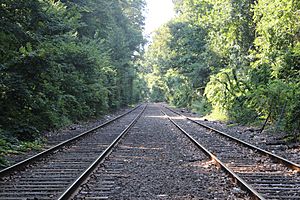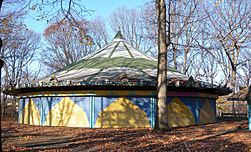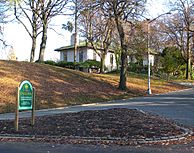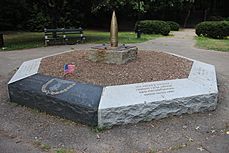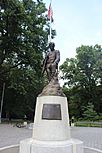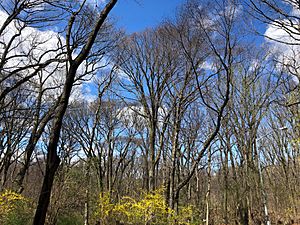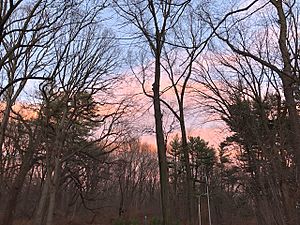Forest Park (Queens) facts for kids
Quick facts for kids Forest Park |
|
|---|---|
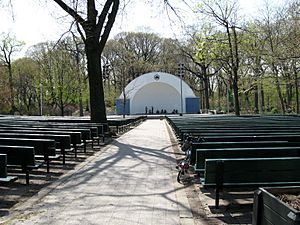
George Seuffert, Sr. Bandshell
|
|
| Type | Urban park |
| Location | Queens, New York City, United States |
| Area | 538 acres (2.18 km2) |
| Created | 1895 |
| Owned by | NYC Parks |
| Status | Open all year |
| Website | https://www.nycgovparks.org/parks/Q015 |
Forest Park is a large park in Queens, a part of New York City. It covers about 538 acres (2.18 square kilometers). This makes it the third-largest park in Queens. It is also the tenth-largest park in all of New York City.
The park was created on August 9, 1895. At first, it was called Brooklyn Forest Park. This was because the area used to be part of Brooklyn.
Forest Park has 165 acres of trees. It has the biggest continuous oak forest in Queens. Some of these trees are more than 150 years old! The park sits on hills that were formed by a huge glacier long ago. It is a safe home for many native plants and animals. Many birds live here all year, and even more stop by during spring and fall migrations.
You can find several trails for walking and hiking. The park also has playgrounds, a famous carousel, a running track, and two dog runs. There's also a pond, tennis courts, basketball courts, baseball fields, and a golf course. The New York City Department of Parks and Recreation takes care of the park.
Contents
History of Forest Park
How the Park Was Formed
About 10,000 to 20,000 years ago, a giant glacier shaped this land. It left behind small hills and valleys. These are known as "knob and kettle" terrain. Native American tribes like the Rockaway and Lenape lived here first. Then, in 1635, the Dutch West India Company settled the area.
The land that is now Forest Park had many different owners. In the late 1800s, officials from Brooklyn wanted to create a large public park. In 1892, the New York State government allowed them to search for land. On August 9, 1895, the Brooklyn Parks Department bought the first piece of land. This is when the name Brooklyn Forest Park was first used.
Because many private owners were involved, the park was put together in 124 separate pieces. This process finished in 1898. A man named James S. T. Stranahan had a big idea. He wanted one huge park that stretched from Jamaica, Queens to Park Slope, Brooklyn. But the city grew too fast for this to happen. Today, Forest Park and Prospect Park (Brooklyn) are the largest parts of his original plan.
Designing and Developing the Park
In 1896, a famous landscaping company, Olmsted, Olmsted & Eliot, was hired. They created a plan for the park. Frederick Law Olmsted, a well-known landscape architect, designed Forest Park Drive. Old buildings on the land were sold and taken apart.
A nine-hole golf course opened in 1901. Its clubhouse was designed in a special Dutch Colonial style. This building now serves as the park's main office.
Carousels were added in 1918. Two of them were later destroyed by fires in 1966 and 1972. Jackson Pond was once used for fishing and ice skating. However, it was later filled in for new projects.
Recent Changes and Events
In 1995, the park celebrated its 100th birthday. To mark the occasion, 100 trees were planted. This project was called Operation Pine Grove. The park uses a greenhouse, built in 1910, to grow plants for many other city parks.
The small ponds in the forest are great for watching birds. Forest Park Drive goes along the top of the glacial hills. In winter, when the trees have no leaves, you can see far away. You can see parts of Queens, JFK Airport, and even Rockaway Beach, Queens, which is almost 10 miles away!
In 2012, Hurricane Sandy caused damage to many trees in the park. One fallen tree also damaged the Forest Park Carousel. But the damage was fixed, and the carousel reopened in March 2013. The Forest Park Carousel is very special. It was added to the National Register of Historic Places in 2004.
Things to Do and See
Forest Park has many fun things to do. "The Overlook" is the main office for Queens Parks. "Oak Ridge" used to be the golf course clubhouse. Now it's the main office for Forest Park.
The park offers:
- The famous Forest Park Carousel
- Playgrounds for kids
- A pond
- Areas for barbecues
- The George Seuffert, Sr. Bandshell, where concerts are held
- A nature center
- Two dog runs (one for small dogs, one for all dogs)
You can also find therapeutic horseback riding here. This is for people with special needs.
Many yearly events happen in the park. These include a Halloween Walk and a Victorian Christmas. There's also Nature Trails Day and battle re-enactments. People from nearby neighborhoods like Kew Gardens, Queens, Woodhaven, Queens, and Forest Hills, Queens often join in.
Strack Pond
Strack Pond is a special pond inside the park. It's a "kettle pond," which means it was formed by a melting glacier. It's located near Woodhaven Boulevard. The pond is named after a local person who died in the Vietnam War. It was filled in during 1966 but was brought back to life four decades later.
Wildlife and Plants
Forest Park is home to many different animals and plants.
Birds of the Park
Many types of birds live in Forest Park. You might see red-tailed hawks flying overhead. There are also different kinds of woodpeckers. Great blue herons and mallards can be found near the pond. Other birds include northern orioles, American kestrels, and hummingbirds.
Many types of sparrows live here too. More than 100 kinds of migratory birds visit the park each year. They stop by during their long journeys in spring and fall.
Other Animals and Seasons
In spring, chipmunks become very active. You can also see squirrels, raccoons, and skunks all year round. On warm days, turtles like to sunbathe in Strack Pond.
In summer, you'll hear the loud buzzing of cicadas. Toads also croak in the evenings. In mid-summer, butterflies hatch and visit flowers like Joe Pye Weed and milkweed.
Fall brings beautiful colors as the leaves change. Many different kinds of trees prepare to drop their leaves. Several types of hawks also pass through during this season. Winter is quiet, but you might see tracks of small animals in the snow.
Trees and Wildflowers
Forest Park has many types of trees. Some common ones are:
- Northern red oak
- Scarlet oak
- Tulip tree
- Shagbark hickory
- White oak
- American beech
- American sweetgum
- Black cherry
Some trees in the park are over 150 years old. They create a tall "canopy" or roof of leaves. Below them, you'll find smaller trees like Dogwood and Sassafras. In spring, wildflowers like white wood aster cover the forest floor. Azaleas, dogwoods, and forsythia also bloom.
In 1912, a disease called chestnut blight damaged many trees. For a while, the park was used for cutting down trees for wood. Greenhouses were also set up to grow plants for parks all over the city. These greenhouses have since moved to other locations.
Getting to Forest Park
Public Transportation
You can reach Forest Park using the New York City Subway.
- The IND Queens Boulevard Line (E, F, M, R trains) stops at Kew Gardens–Union Turnpike.
- The BMT Jamaica Line (J, Z trains) stops at 75th Street–Elderts Lane, 85th Street–Forest Parkway, and Woodhaven Boulevard.
Several city buses also go near the park:
- The Q56 bus runs along Jamaica Avenue.
- The Q11, Q21, Q52 SBS, and Q53 SBS buses run along Woodhaven Boulevard.
- The Q37 bus runs along Park Lane South.
- The Q55 bus runs along Myrtle Avenue.
Other Ways to Travel
In 1895, it was noted that two train lines, the Montauk Branch and the Rockaway Beach Branch, ran through the park land. Today, only the Montauk Branch still has train service.
Forest Park is also divided by Woodhaven Boulevard and the Jackie Robinson Parkway. This parkway was finished in 1935. Even with these roads, Forest Park remains a large green space. It has the biggest continuous oak forest in Queens and a 110-acre golf course.
The Brooklyn–Queens Greenway bike path also goes through Forest Park. This path connects the park westward to Ridgewood Reservoir and eastward to Kew Gardens.
Forest Park is bordered by Myrtle Avenue, Union Turnpike, Park Lane, Park Lane South, and Cypress Hills Cemetery.


